by Tom Gaylord
Writing as B.B. Pelletier
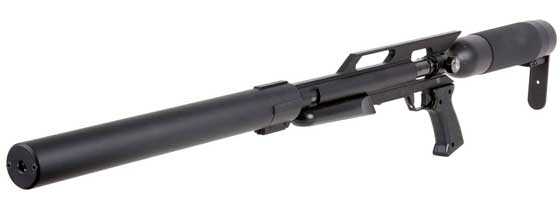
TexanSS big bore air rifle from AirForce.
This report covers:
- Sight-in
- The test
- Tin Starr 210-grain semiwadcutter
- Tin Starr 310 grain flat point
- Hunter’s Supply 250-grain hollowpoint
- Something different
- Hollow base first
- Hollowpoint first
- Last bullet — the flying dumbbell
- What’s next?
- Summary
Today I will shoot the AirForce TexanSS at 50 yards for accuracy. In Part 3 we learned about the bullet tuner on the left side of the rifle. We saw that the .45 caliber Texan SS has a narrower range of adjustment than the .45 Texan I tested for you several years ago. The results of that test set us up for today’s accuracy test.
Sight-in
I scoped the rifle with the 4-16X56 UTG Bubble Leveler scope. The scope sits high above the bore line of the rifle, but the bubble level inside guarantees the rifle will not be canted when it fires.
I first sighted-in at 20 yards. I used the first bullet that I planned testing, and didn’t change the scope setting for the rest of the test. It took 5 shots at this distance to get the bullet where I wanted it — in the center of the bull.
The test
I will be shooting 5-shot groups with 5 different bullets — one of them two times for a reason I will explain when we get to it. Because of that, I left the bullet tuner set just slightly above the 3/4 mark for the entire test. If any bullet or bullets show promise, I can always refine the setting just for them, but that will have to come on another day.
I shot off the MOA shooting bench that I bought at the SHOT Show. The more I use this bench the more I like it. The rifle was rested on a long sandbag that made it steady for each shot.
The wind was blowing 5-7 mph during the test, with gusts to 20 mph. I waited until the gusts died down for each shot. These were the same conditions under which the Hatsan Hercules .45 caliber big bore air rifle was tested a week ago. Let’s get started.
Tin Starr 210-grain semiwadcutter
The first bullet tested was the 210-grain semi-wadcutter from Tin Starr bullets that tested best with the Texan. Though the SS barrel is shorter, I think the rifling twist is the same as is found in the Texan barrel, and this is a bullet of known accuracy.
From the velocity test we just did, I knew there were 3 shots that were close in velocity were possible, so I shot 3 times then refilled the rifle for the last two bullets. Five bullets made a vertical group measuring 2.232-inches between centers. Three of those bullets landed in 0.535-inches, and they are between the other two shots. That tells me this bullet is very accurate in the SS, though I probably need to tweak the bullet tuner a little.
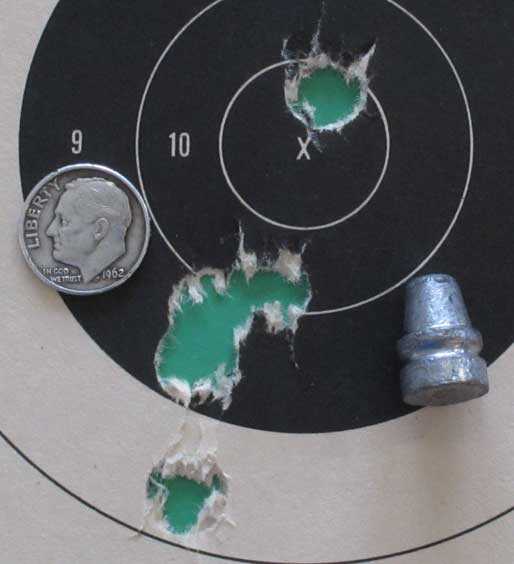
Five 210-grain Tin Starr semi-wadcutter bullets made this 2.232-inch group at 50 yards, with three bullets landing in 0.535-inches.
The group set me at ease, because no matter what else happened, I now had a good bullet for the SS. That bullet would be good for game up to whitetail deer-size. I’m limiting it to those animals weighing 150 lbs. and at a distance of less than 150 yards. A semi-wadcutter bullet slows down in flight faster than a round-nose bullet.
A big bore bullet kills game through loss of blood — not shock. The foot pounds of energy on target don’t make much difference, as long as they are sufficient for the bullet to penetrate the game. This bullet will go completely through a whitetail deer that’s hit sideways in a classic heart/lung shot up to 100 yards, as long as a major bone is not hit. It will break a shoulder bone.
Tin Starr 310 grain flat point
Next up was the Tin Starr 310-grain flat point bullet. This one is much heavier for greater penetration. This would be a bullet to use on mule deer or even the larger red deer that are called Hirsch in Germany. Of course it goes slower than the previous bullet, so let’s see where it hits the target with the same scope setting.
This bullet impacted about 2 inches below the first one. It was still centered on the bull, though. That’s a good thing, because it means you can have two good bullets for distances under 100 yards. I shot three bullets on the fill, then refilled and shot the last two.
Five bullets made a 1.681-inch group at 50 yards. That’s plenty good for hunting out to 100 yards, though with this bullet you will need to see where it lands at that distance. Remember, this test is a 50 yards.
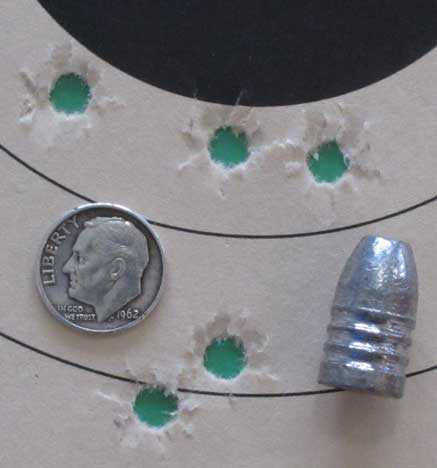
Five Tin Starr 310-grain flat point bullets made this 1.681-inch group at 50 yards.
Hunter’s Supply 250-grain hollowpoint
Next I tried a 250-grain hollowpoint bullet that was provided to me by AirForce. This is a bullet they recommend for their Texan and TexanSS. Five went into 2.48 inches at 50 yards, and the group is still fairly well-centered in and around the bull. Once again, I shot three bullets, then refilled for the last two.
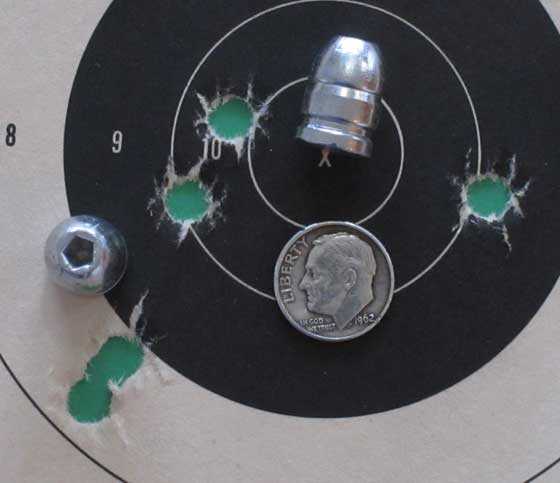
Five 250-grain hollowpoints from Hunter’s Supply landed in 2.48 inches between centers at 50 yards.
Something different
Now let’s leave the world of conventional bullets and look at two experiments that were conducted by Tin Starr Bullets. The first is a design that was suggested by AirForce. Nobody knew how it would turn out, which is why we test. This may be the first time this experimental big bore bullet has been seen, and without a doubt it is the first time it’s been tested in the TexanSS.
The bullet is a deep hollow-base or hollowpoint configuration, depending on how it’s loaded. This is the bullet I alluded to at the start of the test. I tested it both ways, and in a moment we will see how that went.
The bullet is extremely light — 137 grains. Even a .45 caliber round ball weighs 143 grains, so you know that this one is very light!
Tin Starr made a prototype mold to cast this bullet for a proof-of-concept test. It wasn’t made on a production mold that would cost much more to make. However, if there is any merit, it should be evident with the test bullets. Then they can decide to invest in a production mold.
Finally — and this holds true for every Tin Starr bullet seen in this report — these bullets are made from lead that is as pure as can be. Pure lead is very soft and takes the rifling easily with low friction. But it doesn’t cast well. Add tin or antimony to get bullets that fill the mold better and look both sharper and cleaner. Tin costs many times what lead costs, so that’s out. Antimony hardens the lead alloy too much. Bullets cast with it may look better but they shoot worse, until you get the velocity up over 1,500 f.p.s., which no big bore air rifle can do. Hard lead bullets also smear inside of the bore, causing early leading.
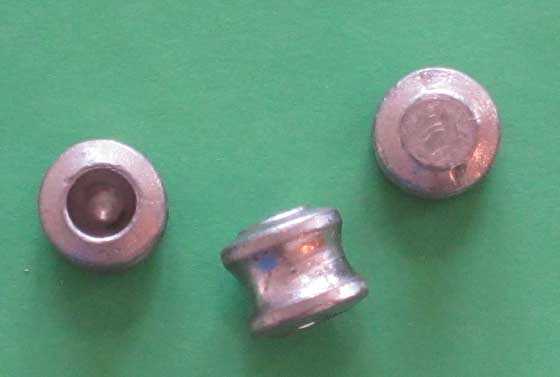
This Tin Starr prototype bullet is either a hollowpoint or a hollow base — depending on how it’s loaded.
Hollow base first
The first target was shot with the hollow positioned at the base. Two were fired on a fill, then the rifle was refilled and the last three were fired. They landed in a group that measures 3.818-inches between centers. Even though this group is larger, they are still centered on the bull.
One thing I did not notice until writing this report is that three of the five bullets tumbled in flight! The hole at the extreme right shows the side profile of a bullet. The highest hole looks like two bullets went through, so the bullet was tipped on an angle, and the one in the X-ring is nearly sideways.
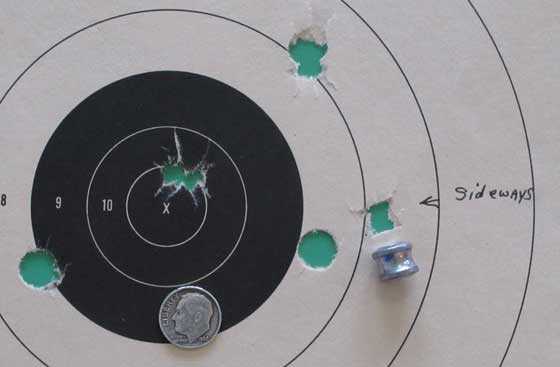
Five bullets shot loaded with the hollow in the base are in a group measuring 3.818-inches between centers at 50 yards. Three have tumbled.
Hollowpoint first
Next I loaded five of the same bullet with the hollow point first. These made a group measuring 4.095-inches between centers. This group also drifted a little to the right at 50 yards. Of all the bullets shot, it was the only one that went sideways a little. I shot all 5 rounds on a single fill of air, because they are so lightweight. If they had proven accurate, more testing with different parameters would have been indicated.
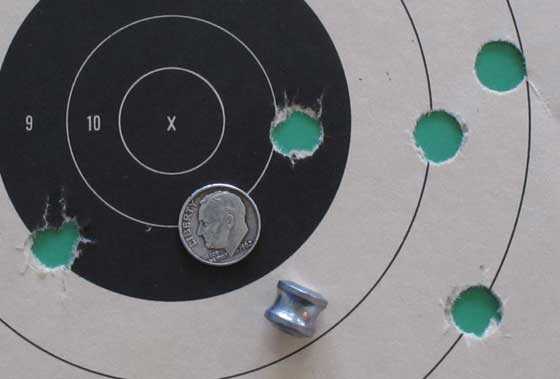
Loaded hollow point first the same Tin Starr prototype bullet went into 4.095-inches at 50 yards. These seem to have flown straight — more or less.
I recommended to Tin Starr that this bullet is a no-go for the TexanSS. Given the results we have already seen, this bullet adds nothing.
Last bullet — the flying dumbbell
The last bullet I tested this day is one I call the flying dumbbell. It is based on the 1960s French shotgun slug called the Balle Blondeau, and over the last 20 years I have never seen it fail to deliver astounding accuracy in air rifles. Even smoothbores can shoot this shape accurately for short distances of under 50 yards. I recommended to Tin Starr that they prototype this shape in a lightweight bullet for the TexanSS.
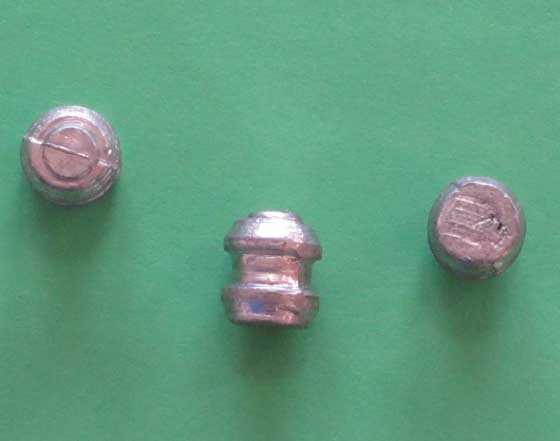
The prototype flying dumbbell is not a pretty bullet — yet.
Once again they made a prototype mold for this proof-of-concept test. And the 182-grain cast slug is pure lead, so we have another rough-looking bullet. However, handsome is as handsome does!
Again I shot all 5 shots on a single fill of air. Five flying dumbbells went into a group measuring 1.072-inches at 50 yards, with 4 of them in 0.573-inches. This is the most accurate bullet of this test by a significant margin!
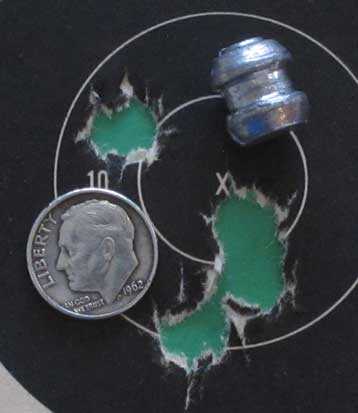
The flying dumbbell was the most accurate bullet of this test. Five went into 1.072-inches at 50 yards, with four of them in 0.573-inches.
I will say that Johnny Hill of Tin Starr Bullets that’s part of the Weatherford Pawn Shop (817-594-8511), thinks the flying dumbbell may not be accurate for longer distances. I will have to test that. I know that many years ago Gary Barnes shot three similar bullets into less than 2 inches at 200 yards with one of his big bores, so I think the design might hold up. Also, if you order some of these they will be rough like what you see here. It takes time and a lot of money to create a custom mold for a high-speed commercial casting machine.
What’s next?
Now that we know which bullets to work with (the 210-gr. SWC, the 310-gr. flat point and the prototype flying dumbbell), the next step is to do some tuner adjusting on the rifle to see if we can improve these results. Based on this test the TexanSS deserves a test at 100 yards. And I have every intention of doing one.
Summary
As you can see, the .45 caliber TexanSS is another barn-burner! It’s what you expect from an AirForce big bore. This is a 400+ foot-pound air rifle that’s quieter than a .22 Short and as accurate as anyone could hope for. It has a delightful trigger and conserves air, plus that tuner allows you to use the full range of 0.457 and 0.458 lead bullets.

BB
I thought the gun Barnes used was smooth bore wasn’t it? If so rifling doesn’t mean as much?
And maybe the design of the bullet/pellet (I think the dumbbell design represents a pellet more than a bullet) is what makes the accuracy. Although the Tin Start is similar but not as accurate. Maybe it boils down to fit more than design???
GF1,
Barnes guns were all rifled. You are thinking of the Chilko father/son team who used the dumbbell bullet in the Damascus airgun show big bore match.
B.B.
BB
Yep that’s what I was thinking of.
B.B.,
I’m convinced that short pellets have no place in airguns shooting at targets beyond 10 meters. There ought to be a formula somewhere that could help designers make an accurate pellet (I know you gave us that assignment several years ago!). Maybe you ought to refer the designer of that short pellet to that article. That pellet needs to be just a little longer in my mind to show some accuracy.
Siraniko
Siraniko,
You need to advise some of the designers of air rifle magazines regarding the merits of long pellets.
Michael
Michael,
Who me? They out to enroll in Tom’s Airgun University and take this course: /blog/2013/03/some-thoughts-on-pellet-design-part-2/
Siraniko
B.B.,
A very fascinating test. Seeing the different shapes is a real treat along with actual shooting of them. My first thought is dumbbells for a .22 or .25. I have tried the bullet shaped ones in both calibers, but the conventional Diabolo JSB’s always won out.
Looking forwards to more testing.
Good Day to you and to all,…. Chris
BB,
I have to admit that I had high hopes for the hollow slug. Tumbling is rough on accuracy though.
I have been trying to find the Balle Blondeau design in .357. I would really like to try them in my HM1000X. The short design should allow them to work well in the magazine.
BB,
Aeromagnum makes the 176-grain .45 SPARTAN of the Balle Blondeau design. Perhaps you should contact them.
http://aeromagnumaeromunition.com/
RR,
The Spartan isn’t really a Balle Blondeau. It’s similar, but not the same.
B.B.
B.B.,
I checked out the linked company and had a question or two. I called and it went to voicemail so I hung up planning to call another time. Well not more than a half hour later I got a callback from Al; even though I hadn’t left a VM. We talked for quite a bit of time and sorted out some misconception s of mine about the .308 rounds including the ones (more aerodynamic and bone breaking) that they are currently experimenting on. Their product looks good and their attitude as a company is even better. I’m going to place an order with the Depot in Utah to send me 50 of the Aeromagnum .308 hollow points to also try in my DAQ.
I may go back to casting my own slugs some day! But at my advanced age I like to shoot much more than I want to spend my time casting. I may need to move one of my spring preload/rate adjusters from one of my .25 caliber DAQs.
Have any thoughts on the adjuster on the .308?
Any chance Tin Start Bullets has something for the .308 or a “dumbbell” for the .458 DAQ?
I’m looking forward to your report on the Texan SS at 100.
Thank you Tom
shootski
shootski,
I have a .308 but haven’t started testing it yet. Try .309 bullets in it. I hear they are best.
Tin Starr is just starting testing the .45 caliber bullet. If the dumbbell sells they will probably look at the other calibers.
B.B.
Mr. Gaylord:
Thanks for today’s posting and your inclusion of the flying dumbbell or Balle Blondeau in your test protocol. Some of us have never seen or heard about this design before. Outside of historical bar shot canon ammunition, this is really something new
In your next report, if you return to the flying dumbbell or Balle Blondeau, could you please address what accounts its accuracy? Is is spin stabilized or drag stabilized? Or a combination of both? And is this design only practical in big bore bullets? Or would a similar design work in a .177 10 meter pellet?
Respectfully,
William Schooley
Rifle Coach
Crew 357
Chelsea, MI
William,
I believe the stability is a combination of spin and drag, because the smoothbores loose their accuracy after 40-50 yards, but the rifles keep it out to at least 200 yards.
B.B.
BB my friend has the Korean 45 rifle now called a Seneca?? and he bought with the rifle overpriced cast bullets 3 different types. none were any good. so I had a Lee mold for the 45 Old Army BP revolver and cast a bunch of bullets for his rifle figuring it cant be worse. we shot tiny groups with them using a hand pumped and pumped enough air to fill the good year blimp lol. guys should forget the cast bullets they are selling and get Lee molds and a Lee production pot they are cheap enough and after spending $1000 it is well worth it
Mildot52,
You and I know that, but you can’t convince somebody who has never tried it. These are the same guys who buy off-the-shelf 5.56/.223 Rem ammo and wonder why their ARs are 3 MOA guns.
B.B.
The Texan looks to be quite a rifle but it is the new bullet designs that really got my attention.
Think that the latest rage of putting pointy-thingies on the front of the pellets may look cool but the designers might be better off trying to make a more aerodynamic pellet/bullet with better stability and BC.
I keep on looking at the finned shotgun slugs and wondering how they would do if they scaled down to .22 or .25 caliber. The lead fins would be too fragile to tolerate much handling so a weight-forward hollow Foster style lead bullet with a plastic fin tail might work.
I no longer hunt big game so I don’t have a need for a big-bore. It might be interesting to get one and spend some time playing with different bullet designs.
150 pound whitetail would be a young animal around here. Most of the adult deer on my property are 200 + pounds and a couple are close to 300 on the hoof.
Happy Monday!
Hank
Hank,
Those remind me of Lazy Dogs. Actually, they also remind me of the little metal toy that you’d put one cap in and throw up in the air. It would come down on the sidewalk and go, “BANG.”
Michael
actually looks like an RCBS brass shaver used to clean the inside and outside neck of a case after trimming
Michael,
I remember those “rockets” – a quarter would buy one and enough caps to keep you busy all day. 🙂
Hank
Michael,
the little cap rocket is the first thing that came to my mind. You can still buy them today, but instead of a paper cap, they take the plastic cap. I watch a young lad play with one outside of a feed store. It seemed really loud. So I walked up and asked him why brand of cap was it, since it was so loud. To my shock, it was percussion caps you’d use on a black powder gun. After it landed I picked it and looked at it. I noticed some of the cap was missing. I asked him where he thought those metal pieces were going. He said he hadn’t thought about that. I told him he’d put an eye out.
Doc
Doc,
YIKES! That has to be just pot metal. I understand a percussion cap isn’t such a big deal, but pot metal + corrosion + metal fatigue = an unpleasant outcome.
Michael
WOW Michael,
That memory jog you provided just instantly returned me to my “hard” play days in the ’50s!
Kid’s these days don’t get to play with anything that “dangerous” and FUN any more!
Thanks for the Wayback Machine ride!
shootski
Shootski,
Giving such tours with the Wayback Machine is my specialty. :^)
Michael
Hank,
300 pound whitetail are something we only dream of down here. 😉
Don’t forget the Brenneke slugs and the slugs that look like big pellets!
B.B.
B.B.
Think it is the cold Canadian winters that naturally culs the smaller animals and leaves the bigger body ones to breed. I understand that the deer in Florida are quite small.
The deer in my area are not heavily hunted and live to a ripe old age. I have a shed from one of the local bucks with a main beam that is the size of my wrist! His tracks are 3 3’8″ long. I’ve seen a number of deer that dressed 220 to 230 pounds (about 260 to 275 pounds live weight) and he is bigger.
Here is a picture taken out my front window… I am on a first name basis with several of the deer who will approach within 5 or so feet of me, the others are comfortable at 20-25 feet. 🙂
Hank
Hank,
Now that’s just bragging! 😉
I guess it compensates for the clod weather.
B.B.
Hank,
Where is your Saltlick located????
That looks like a friend’s house in Northern Cali when his dad used one to bring them in.
He had a half door (Dutch Door) that he opened and harvested them from inside his mud room.
I’ll need to get the backstrap out of the freezer now!
shootski
Shootski,
No salt-lick, they come for corn when it is very cold/stormy.
There were 14 here tonight. A couple ran over to greet me when I was putting out the garbage and the rest showed up when they heard me open the garage door. 🙂
Hank
Hank,
30 years ago I used to see something like that every early morning when I drank my coffee. I’d look out the window and see shapes against the snow in the dark and just stand still as the morning light came up and revealed them.
I lived rent free in a house in the middle of 180 wooded acres. In exchange I agreed to walk a half mile to a mile a day on the many trails through the woods. The owner wanted someone living on the property to discourage poachers. He had the perimeter fenced off with waist-high barbed wire with big metal signs every 30 yards that stated, “No Trespassing. No Hunting. Poachers will be prosecuted.”
One cold twilight I was just heading back to the house on a trail when I heard human footsteps crunching in snow. From around a corner three guys in orange vests with deer rifles appeared. I flashed my Mag-light at them, and they turned and ran. I ran after them and chased them to where they had cut barbed wire to get in. I chased them for about another 20 yards into the neighboring frozen farmer’s field. They ran all the way to their truck parked up on the road.
I laughed all the way back to the house. Think of it. Me, unarmed, alone, chasing three armed guys through the woods.
Repairing the fence the next day wasn’t fun, though, as I remember it was a cold day. :^)
Michael
Michael,
Sounds beautiful! What an environment!
When we were looking for our retirement property I wanted to get 100 + acres and only came out to view this 10 acre property because my wife wanted to see it. What it lacked in size it made up for it in its diversity in flora and fauna. We back on to a 55 acre spring fed beaver flood so in addition to hardwoods and cedar bush we have marsh and pond habitat complete with all the water-based birds, mammals, reptiles and amphibians. Being a beaver flood there are no boats or jetskis so it is a nice quiet place for me to kayak in.
I really lucked out and consider myself very fortunate to be able share this property with all the other residents. The deer come for hand-outs when the weather is bad and we keep a well stocked bird feeder to cater to the over 60 species of birds live here. …My own little paradise 🙂
Have a great day Michael.
Hank
Hank,
Awe Man!!!! I wants me some of THOSE! I would buy them for an air gun purely on the mega cool factor!! 🙂
I was looking at pellets over the weekend and saw those ones in a plastic case/shell. They never did show what the tail end looked like. I wonder. I have tried the bullet shaped ones in .22 and .25, but the conventional JSB’s always won out. I have tried the metal tipped ones too.
BB—Lyman has a .45 cal. collar button bullet ( 457130 ). I used to have 2 trapdoor Springfield rifles. I used the bullets designed for the Ruger black powder revolver ( both hollow point and solid ) for indoor gallery loads. They shot well, unsized . A friend gave me some of the collar button bullets, and they also were accurate. My club had an outdoor 25 yard range, and these loads destroyed many a bowling pin. I used auto water pump grease for the lube, and the data from an old Lyman cast bullet manual. -=—–Ed
Ed,
Sometimes the simple things are also the best.
B.B.
Vana2—The bullets in your post look like 1930,s Flash Gordon rockets! I almost expect to see a hatch open, and see Buster Crabbe, or Emperor Ming emerge !—-Ed
Vana2—- I was re reading your post. If the slugs are too fragile to be scaled down, why not scale up the gun? —Ed
Ed,
Think that these “rocket bullets” are carried in a sabot. Don’t know what caliber they are but if they are made of pure lead the fins would be too soft to survive even gentle handling.
A round or conical lead bullet with an aerodynamic plastic base is what I was thinking about.
Hank
B.B.,
That Tin Star prototype that went sideways reminds me of the Crosman Ashcan.
Michael
BB—I would like to know if those simple collar button bullets would be the best in your Texan !——Ed
Ed,
They would be worth a try, that’s for sure.
B.B.
B.B.
Wow that is a pretty dramatic result with the dumbbell design! I know it is not your design but good job coming up with it in the context of these air rifles. I bet we will see more of those in the future now that you put these results out here.
Also nice shooting!
Best regards,
Carel
Carel,
Yes, these are not my design. I don’t even think the French were first with them, but the success of their Balle Blondeau certainly opened some eyes around the world.
B.B.
Off subject, what about a multi shot break barrel that, unlike Gamo & Crosman, does have open sights (very high up/tall sites though). Hmmm, this race is getting interesting
https://hardairmagazine.com/news/new-hatsan-speedfire-air-rifle-launched-2018-iwa-show/
Doc
BB, is there any possible advantage in using a reduced caliber bullet in a sabot, like in BP guns?. Just curious.
Henry,
I’ve often wondered that myself. Seems they’d be less friction with the plastic. I know they can be accurate in firearms. Hmmm
Doc
Henry,
Higher velocity would be the main advantage. But big bore are going for power and a lighter bullet would reduce that, so I don’t know.
Hasn’t been done very much, if at all.
B.B.
BB,
Didn’t you report someone fielding a Big Bore sabot round at last years SHOT show?
If Henry_TX was referring to a smallbore sabot, as I thought he was, wouldn’t they share the problem from plastic fouling that you have discussed in other reports as regards pellets like the Prometheus?
Half,
If I did I don’t remember it.
Yes, plastic fouling would need to be cleaned.
B.B.
BB,
I went back and looked at your 2017 SHOT series. Umarex was showing something called ARX in .50 cal that you speculated would be for their Hammer. Here’s the link if you want to look Henry_TX /blog/2017/01/2017-shot-show-part-1/
Half,
Oh, yeah! I have a small box of samples on my desk! I forgot!
B.B.
Sorry I didn’t answer before, work got a bit hairy. Anyway, yes, thanks Halfstep for the link, however I was thinking about something a bit more traditional. My idea is that a sabot should allow a light for caliber, say a .357 158 gr lead bullet with a decent BC, to get good speed thanks to the big 45 caliber cup pushing it. That of course translates into a flatter trajectory for less hold at long(er) range(s). Then again, range and power do not count if the bullet doesn’t hit the target in the right place so the main potential drawback I see is lack of accuracy. It will take some testing to know.
Thanks to all for your answers, I am always learning something new here.
Henry.
Halfstep, I posted my answer below. Thanks!
Henry
B.B.,
I concur with Henry_TX concerning the sabot concept. Obviously, they would have to be loaded singly, in most if not all cases, but the results could be well worth it. Hornady markets a .45 caliber sabot which holds a .40/10mm caliber bullet. I personally believe that using one of their XTP pistol bullets in that caliber might be worth trying. They are available in bullet weights of 155, 180 and 200 grains with BC’s of .137, .164 and .199 respectively. The only fly in the ointment may be that the sabot/bullet assembly may be too tight for some barrels.
Bugbuster
Ah, those pesky fliers. But that is still great shooting with the dumbbell bullet.
Derrick and I have been noticing all the different places that Wharncliffe blades are used. These include the popular Santoku style used by chefs as well as the knives used at Subway! With all that slicing, that blade design must be effective. Best of all, with its straight edge, all of B.B.s straight razor experience should translate perfectly. I’ve already picked mine out.
Matt61
Got my .22 Pelletgage today it’s very nice. Now I Have something airgun related I can do while watching tv with the fam. Can’t wait to get home tomorrow and hopefully find a Crosman 101 on the porch.
Carl
Carl,
I have one in .25. I could never tell the difference and if I could, I could not repeat the results. It could be that it does make a difference and it is just me that can’t shoot well enough for it to show up. Add a grain scale in there too to make it interesting. I have done both.
The (upside) to both is that it eliminates variables. I always like that. The (downside) is that now that I have eliminated head size and weight,… that means that I can’t blame my bad shots on those 2 factors anymore.
Keep us posted and best of luck with it. I hope it helps.
BB and Chris
Chris brings up a point I sometimes find perplexing. It is being unable to repeat the results. Me too on that. He is referring to head diameters but too often I can not validate a rifle’s hold technique for example. If you are unable to repeat something that has worked before what is the matter? Do you have a go to check list to identify most likely causes? This usually happens with so-so accuracy guns but not always. Maybe some guns are just cranky and only shoot good on odd numbered days. I do suspect the culprit is me but what?
Decksniper
Decksniper,
My advice?,…. just do the best you can and do it the same each time. My new plan of attack this year is to implement Vana2’s wind flags. I am sure that not seeing the wind has affected my shots.
Chris
Thanks for the reminder to “do it the same each time”. I had good shooting awhile ago doing exactly that with two rifles. One is a match rifle, the other is a so-so rifle for accuracy. My curiosity for finding a better hold sometimes takes me away from one that worked.
Looking for a better trigger squeeze technique is another variable. I experiment every outing, especially when a gun has a horrible lawyer proof 7 pound weight pulling the trigger the other way. Maybe I should rig a clamp to pull the trigger. Today I simply went to the standard trigger finger squeeze.
Decksniper
Decksniper,
I find myself experimenting all of the time myself,.. in one way or the other too. Sometimes, like in the Spring, I find that I am not doing one basic thing or the other. A check list like you said is not a bad idea. There is no replacement for practice and repetition. I always cut myself some slack and give myself some “warm up” shots. In the Spring, the whole session can be a warm up. Then there is those days that you just know that you are not on your game.
It is sweet though when it all comes together and you have a really good day and maybe even have done your own personal best/set new records. Now,… can I repeat it the next time out? 😉
Coduece,
I have .177 and .22 gages and have found that it is tough to watch TV while using them, but listening to an audiobook is a perfect activity to take the tedium out of the task.
Half
Half
Right I’m seldom watching anyways, my wife is big into audio books guess I’m gonna half to try one. Ok about the comparison between the 50 and the tx. Yes I feel that the hw 50 shot cycle is harsher than the tx. Chris had a vortex kit installed and I used Lucas red and tacky on the hw 50 spring. Also it seems there is more apparent movement after the shot with the hw 50. I hadn’t shot the 50 since October and I forgot how much hold over was required at 50 yds. So I need to work on the 50s scope set up.
Carl
Carl,
I weight sort and then size the pellets that I am use for sighting in, special testing, serious target shooting and small game hunting. The rest of my shooting (75%) is right out of the can.
I will typically do a quick sort of 50 pellets to see if there is any glaring inconsistencies. If I get a bad can then I mark it and might sort the whole lot.
When sorting, I am really just trying to remove the non-conformists that I strongly believe are the “fliers” in the group.
This year I plan to see if I can determine what head diameters that my rifles prefer. Think that is going to involve a lot of shooting 🙂
You have a 101 coming? Great stuff!!! They have a unique balance and feel to them, hope you like yours!
Hank
Hank
What a fabulous photo thanks for sharing it, you truly have a slice of heaven there. And thanks for the advice on using the gage that’s why I posted to get input. Yes I’m stoked about the 101 I really like the looks of it that’s the biggest reason I got it. That and so I can compare it to my 392.
Carl
Carl,
Hoping that your 101 is shoot-ready! They are a fun rifle.
If you need to do some work on yours let me know and I can pass on what information I have.
Cheers!
Hank
Hank
Thanks they said it doesn’t hold air so I’m going to get some transmission stop leak on my way home today. I will definitely be posting pics if it shows up today.
Carl
Carl,
If it isn’t holding air then there are two small gaskets and an O-ring that likely need replacing. Don’t think that the Stop Leak will fix that but you can try.
Check this site for some detailed information, this is the link to the resealing post, Rick also has one on disassembly…
http://ricksshop1.blogspot.ca/2013/09/crosman-101-reseal.html
Hank
coduece
I was bidding on one in similar condition and let it go to a higher bidder… If that was you I am so happy for you! The 101 is really the last on a list I have been collecting.
Have faith in the oil! I bought a nasty (beautiful to me) benji 312 that was very gritty (pump stroke) and rusty on the trigger and guard. I put 12 drops of pellgun oil and now it shoots the pants off my 342 that I spent more on… for the seller to do the same thing to it… (pawn shop lubed it up with so much it was ALL over the gun)
I have found that even though I like my older ones better my new 392 is a shooter at heart and can hold them off.
Keep us updated on your findings sir!!!
PH
Thank you, I don’t think we were bidding against each other as this was a buy now. My fingers are crossed about the oil I bought a bottle of transmission seal conditioner ? And have Pellgunoil oil as well. I thought it would come today but alas I’m still waiting. The gun was listed from a sporting goods store in Massachusetts. This blog is so full of supportive followers I really appreciate it and your comments!!
Carl
Chris
Right I got it mostly to see for myself the variation in head sizes. I have all the sizes of HN ftt as well as all the sizes of the Barracuda match pellets. Now I can see how they measure compared to the size on the tin. Also when I shoot crosman pellets I swear I can feel size differences when I load the pellets, now I can see for myself what’s going on. Jerry is a great guy and has been very helpful to me so I really wanted to get one of his gages.
Carl
I’m going through your notes right now.
Coduece,
I think you are going to find that, in .22 at least, that the FFTs are going to be off in all head sizes and Crosman Domed and HP pellets will have a line of flashing on them that will require you to give them a little extra force through 1 or 2 larger holes to get them to read their true diameter. That has been my experience, at least. I have also found that the actual pellets that gauged at one size on one day will measure a size larger or smaller on another day from what I assume to be thermal expansion of the holes and/or the pellets. I haven’t measured many .177s yet so I don’t know what to expect there and no .25s at all. The only pellet that I have gauged so far that was right on the money for the whole tin was JSB Ultrashock in .22. I would like to hear what your experience is, at some point, in any calibers or brands that you may gauge.
Half
Half
Well so far you were spot on about the head sizes. the 5.53 ftt im playing with have shown some variation for sure. So do you think the perceived harshness of the hw50 compared to the TX is more about the quality of the gun innards or just the extra weight of the TX smoothing things out.
Carl
Carl,
The extra weight always helps. The Vortek kit which I installed will cancel out any vibration, if there ever was any,.. which I do not recall any. A well made piston and guides on a stock gun makes all the difference.
Gunfun1 swears that he can tell the difference in shot (cycles) if he is shooting different pellets. A harder air hit (more bump), more resistance (pellet size), longer to leave the barrel (heavier/lighter pellet),… etc., etc,…. I do not shoot enough to be that discerning.
Carl,
My experience has been that head sizes fall into 2 general sizes, with very few rouges. Weight is another story altogether. I can get 30% + 40% splits with some 5% and 10% splits to either side. A bell curve, if you will. The Crosman experience does not surprise me. Crosman weights in .177 where all over the place. I had some cheapy .177 air rifles for awhile. Save you some egg cartons! 😉
Since you seem to like the HN’s,…
Barracuda Match, 21.14, 5.53
Field Target Trophy, 14.66, 5.53
Sniper Magnum, 18.0, 5.50
Sniper Light, 14.0, 5.50
….. appear to be what I have tried.
Chris
Egg cartons are you reading my mind? I was just trying to think of a way to keep the sizes separated thanksbuddy!
Carl
Half
The biggest thing I learned after shooting both guns was how nice the bubble level scope is compared to the 3/9 center point scope. Until you have something nice, well lets just say it like this you don’t know what you don’t know. I didn’t know how fat the cross hair in the CP scope was, and how it was inhibiting my aim until I got the bubble level scope. And that level is worth the price of admission itself.
Carl
Coduece
We was talking about the shot cycle the other day of your Tx and HW50s.
So the 50 does bump more than the Tx? So does that mean it’s easier to shoot the Tx because of less gun movement?
And yep I think getting the right weight and pellet fit does change shot cycle. Too light or less tight of a fit tends to slam the piston on a spring gun. But on the other hand if you get too heavy of a pellet and tight fit it can also bump the gun from the piston hitting the cushion of air. So the right fit of pellet along with the right weight can smooth a gun out. It just means you got to try even more pellets to see what change takes place. And then there is trajectory to consider and retained energy for the type of shooting you plan to do.
Definitely more to than meets the eye. 🙂